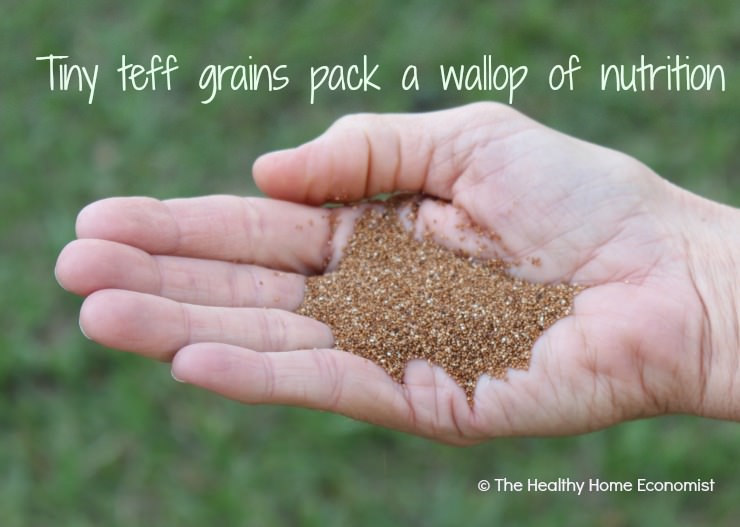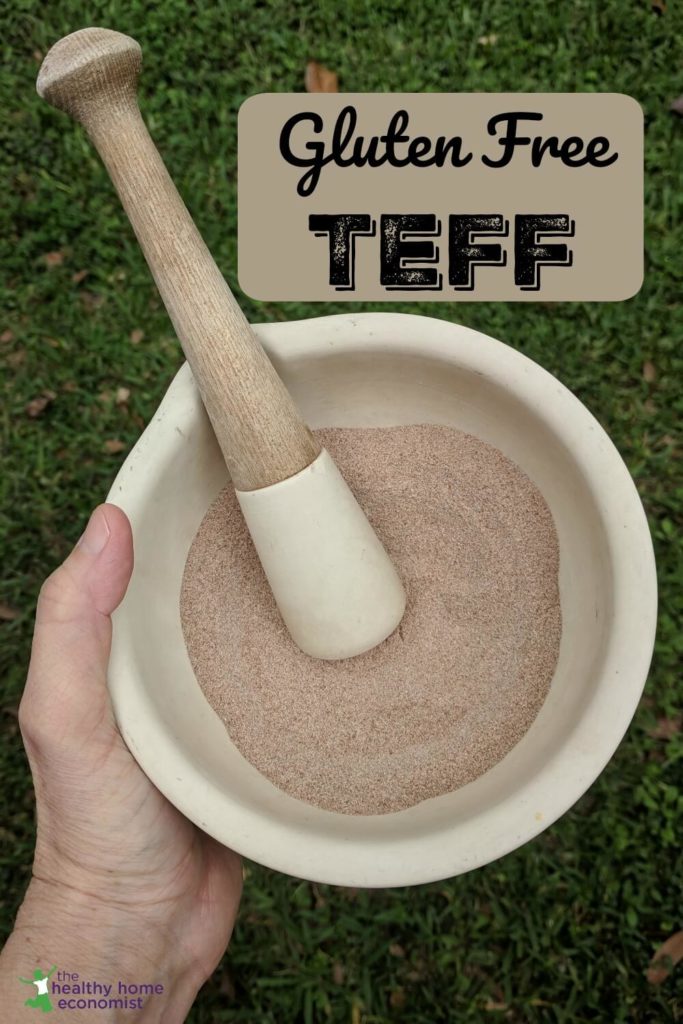 I first tasted the delicious, gluten free grain known as teff shortly after my husband and I were married. We met after work at an Ethiopian restaurant that we’d been wanting to try for quite some time. My husband was born and lived his early years in Uganda, and he was eager to introduce me to some of the flavors of his home continent.
I first tasted the delicious, gluten free grain known as teff shortly after my husband and I were married. We met after work at an Ethiopian restaurant that we’d been wanting to try for quite some time. My husband was born and lived his early years in Uganda, and he was eager to introduce me to some of the flavors of his home continent.
I was immediately enthralled and delighted by the basket of soft, spongy flatbread that was brought to our table to use as an edible utensil for our meat stew.
Never having experienced the light, slightly nutty flavor of teff before, I asked the waitress about the bread’s origins. She proudly explained that injera is a traditional fermented bread that is a staple in Ethiopia.
Traditional Teff Consumed for Thousands of Years
According to the Whole Grains Council, teff is thought to have made its debut in the human diet around 4000 B.C. in what is today the country of Ethiopia. Ethiopians obtain approximately two-thirds of their dietary protein from teff. The ultra tiny grain, smaller even than a chia seed, is what Ethiopia’s famously competitive long distance runners credit for their energy and stamina.
The tiny size of the teff grain, which can appear dark reddish brown to yellowish brown to ivory, made it the ideal food for the semi-nomadic life common throughout Ethiopian history. Only a handful of seed as shown in the picture above will sow an average size field no matter whether water-logged or dry! Thus, this practical grain is a dependable staple no matter what the environmental conditions.
In addition to climate, teff will grow at a variety of altitudes – from sea level to nearly 10,000 feet (300 meters). Its incredible versatility and hardiness has resulted in cultivation in diverse areas around the world. This includes mountainous Idaho, dry Australia, and low lying, wet areas of the Netherlands and India.
Is Teff Gluten Free?
Teff is one of the most nutritious of all gluten free grains.
Despite its tiny size, teff leads all other grains, gluten free or not, in calcium by a wide margin. This includes nutritious einkorn and millet.
It leads Paleo friendly foods used to substitute for grains like cassava and buckwheat as well.
Nutritional Information
Teff is high in many critical vitamins and minerals.
Magnesium, calcium, potassium, zinc, copper, and manganese round out the top six mineral nutrients.
Teff is extremely rich in B complex. It contains excellent amounts of choline, Vitamin B3 (niacin), Vitamin B6, Thiamin, Pantothenic Acid, and Riboflavin.
Teff Contains a Special Kind of Fiber
The biggest health benefit of teff may very well be its unique type of prebiotic starch.
Teff is high in resistant starch, a special type of dietary fiber only recently getting much attention from the research community. Resistant starch benefits blood sugar management, weight control, and overall health of the large intestine.
Up to 40% of the carbohydrates in teff are composed of gut strengthening resistant starches!
Milling Teff Grains
There is only downside to this amazing grain in my experience cooking and baking with it. Can you guess? It is so tiny that most grain mills can’t even grind it into flour!
Unless you have a special grain mill that can manage teff’s ultra miniscule size, it is best eaten in whole form as a delicious, mild, slightly nutty tasting porridge. Alternatively, you can add it to soups or stews to thicken and add texture.
 How to Sprout Teff Grains
How to Sprout Teff Grains
The tiny size of this gluten free grain requires only 36 hours or less to sprout – the shortest time of any grain. This is likely due to low amounts of mineral blocking phytic acid, although I was unable to find definite numbers on this to confirm.
If you would like to sprout your teff grains before cooking to add additional vitamins and render it even more digestible, follow these steps before cooking:
- Place 1 cup in a glass sprouting jar (I use these).
- Rinse the grains several times with filtered water until thoroughly wet. Drain completely.
- Lay the sprouting jar on its side to allow the circulation of air.
- Every few hours, rinse again and reset the jar on its side.
- Anywhere from a few hours to at most 36 hours (depending on the time of year and warmth/humidity in your home), the tiniest of buds will appear (they are very hard to see) and the sprouted teff grains will be ready for cooking (see toasting step below).
Teff Recipes
Toasted or soaked teff porridge is my personal favorite for a hot breakfast cereal. It beats out even that old stand-by overnight oatmeal. It is easy to make and a great place to start with teff in your kitchen.
This is especially true if you don’t currently have a specialized appliance that permits easy grinding of the tiny grains into fresh flour. I don’t recommend purchasing the flour for baking, as much of the nutritional benefit is lost within a few days of grinding.
If you enjoy the taste of teff after trying it, I recommend gluten free soaked amaranth porridge too. Amaranth is also slightly nutty in flavor and offers an excellent plant protein profile.
References
How to Mix and Use Gluten Free Flour
Boma: A Taste of Africa (Best Restaurant at Disney World)








I can’t even imagine how one could soak – and then drain – teff. Coffee filter, maybe? We enjoy the toasted porridge. No soak, no drain, not sprouted, not sure it matters that much
.
Hi sarah you know how much i love my Jovial flour, but i got a package of teff I grind it myself and i did the Injera, ,amazing, and easy to do, now im hook to it
Hi Sarah,
My Name is Samuel, and I grow up eating Teff in the form of Injera ( it’s like a bread baked and sour). Personally, I don’t have that much of the nutrition value of Teff, in-fact this is for most Ethiopian’s we just eat it as a culture. These day’s I am very much interested in reading the nutrition details, and thanks for sharing this article, If you want to get Teff couldn’t verify its organic state, but I don’t think there any concept inorganic back home in Ethiopia yet, anyways let me know if you want, and I can share you a couple of contacts.
Sam
Any idea if the very high manganese levels would pose a problem? Like aggravating adhd or autism.
Thanks!
If you have autism in your household, best to consult with a practitioner who specializes in this to determine if teff is right for them or not.
Hi Sarah,
I cannot find organic Teff. Do you have source?
Thank you!
I haven’t found an organic source yet either!
My finest seive allows teff to fall through it. So I’ve given up on teff..
Hi Sarah!
I don’t see the instructions on how to soak the teff. Shouldn’t teff be soaked similar to oats?
I don’t soak mine. Teff is not really a grain .. it is a pseudo cereal.
What type of resistant starch is in Teff? Rs1, 2, or 3? Does making porridge out of it destroy all the resistant starch, or what percentage is left over?
I haven’t seen any studies on teff specifically, but on potato starch, RS is destroyed over 130 F although a portion of it is regained after it is cooled.
I recently tried teff for the first time but I found it very gritty.
The cooking instructions on the package did not say to rinse it first. Are you supposed to?
Thanks!
I’ve never rinsed it first. Perhaps you didn’t cook long enough? Mine has never been gritty.
Hello Sarah!
I tried to sprout red Teff seeds the same way as other seeds with soaking overnight in water and rinsing two times a day, but nothing happened. Doesn´t these seeds sprout that way? And how may days will they grow before I need to stop the prosess?
Sincerely
Jan R Eriksen
Sometimes the seeds are irradiated. Did you get organic? Usually organic ones will sprout as they haven’t been harmed.